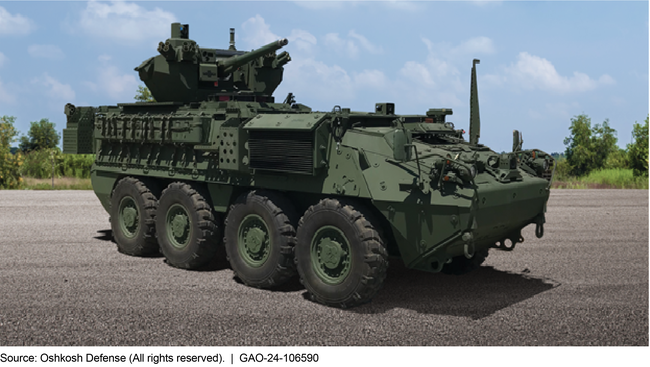Army Modernization: Production Challenges for Stryker Upgrade Reinforce Need to Follow Acquisition Leading Practices in Future Efforts [Reissued with revisions on Apr. 3, 2024]
Fast Facts
The Army's Stryker combat vehicle is an 8-wheeled armored vehicle that transports infantry into combat. To respond to increased competition from Russia, the Army tried to rapidly upgrade its existing Strykers to have increased firepower.
But in doing so, the Army didn't fully analyze and address potential production risks. As a result, it had hardware and software issues with the upgraded Strykers.
Our leading practices for acquisition include production readiness reviews and other measures to help prevent such problems. We recommended the Army apply these practices before beginning production of future Stryker upgrades.
A Stryker Vehicle with the Medium Caliber Weapon System Upgrade

Reissued with revisions on April 3, 2024 to correct typographical errors on the Highlights page and report page 16.
Highlights
What GAO Found
After the drawdown of U.S. Army armored combat vehicles from Europe in 2013, the Army reassessed threats in the region and determined that its Stryker brigades did not have sufficient firepower compared with potential adversaries. The Medium Caliber Weapon System is one of the Army's latest modernization efforts to increase the lethality of its Stryker Family of Vehicles Program.
The Components of a Medium Caliber Weapon System

GAO found that the Army followed leading practices when developing requirements for the Medium Caliber Weapon System. In 2018, the Army used the lessons learned when field testing 83 modified Stryker vehicles delivered to the 2nd Cavalry Regiment in Germany. It used the 2nd Cavalry's experience to inform and refine weapon system requirements, including increases in lethality, survivability, and situational awareness. Subsequently, the Army developed an accelerated acquisition approach for the system by placing it within the Stryker Family of Vehicles Program, rather than designating it a separate program of record. This allowed the Army to minimize documentation required for approval. According to program officials, the accelerated approach was intended to shorten the acquisition by 2 years.
The Army, however, did not fully implement leading practices for acquisition to mitigate production risks, which were introduced, in part, by using a different turret and chassis than what was tested in Germany. Since production started in March 2022, the Army found problems with the contractor's manufacturing processes as well as software issues. Ultimately, this resulted in the Army halting acceptance of vehicles in February 2023, after 19 had been delivered. These challenges may have been identified and addressed earlier if the Army followed sound acquisition practices, such as conducting a production readiness review and ensuring that software worked as intended before ordering most of the 269 vehicles. While the Army mitigated its cost risk by awarding fixed-price orders, the time needed to address production issues will delay fielding by a year. Implementing leading practices for acquisition in production would ensure that the Army develops sufficient knowledge about production maturity for future Stryker upgrades prior to entering production and potentially avoids the issues experienced with the Medium Caliber Weapon System.
Why GAO Did This Study
In response to a 2015 urgent need request from a unit in Germany, the Army developed and fielded a limited number of Stryker combat vehicles with increased lethality, including an uncrewed, turreted 30-millimeter automatic cannon on a Stryker. After testing, further modifications were made and a competition was held to produce additional upgraded vehicles for all Stryker brigades. This upgraded vehicle was subsequently termed the Medium Caliber Weapon System.
A House report includes a provision for GAO to review the Army's efforts to upgrade and improve the lethality of the Medium Caliber Weapon System. This report addresses the (1) requirements and acquisition approaches for the system, and (2) extent to which the Army followed relevant GAO leading practices in identifying and mitigating risks, among other issues.
GAO reviewed and analyzed relevant policies, requirements, and acquisition documents, and contracts. GAO also interviewed Army and Marine Corps officials and a representative of the contractor responsible for the upgrades.
Reissued with revisions on Apr. 3, 2024
Reissued with revisions on April 3, 2024 to correct typographical errors on the Highlights page and report page 16.Recommendations
GAO recommends that the Army apply acquisition leading practices before beginning production of future Stryker upgrades. The Army concurred with the intent of the report without specifically addressing the recommendation. GAO continues to believe that the Army should implement the recommendation.
Recommendations for Executive Action
| Agency Affected | Recommendation | Status |
|---|---|---|
| Department of the Army | The Secretary of the Army should ensure that Program Executive Office Ground Combat Systems applies acquisition leading practices to manage and address production risk to inform future Stryker upgrade efforts. (Recommendation 1) |
When we confirm what actions the agency has taken in response to this recommendation, we will provide updated information.
|
